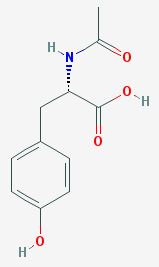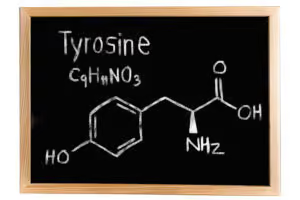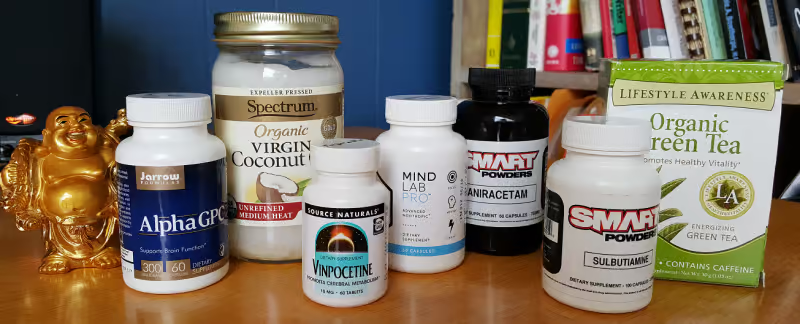Table of Contents
N-Acetyl L-Tyrosine (NALT or NAT) is a highly bio-available form of the amino acid L-Tyrosine. Your brain uses the enzyme tyrosine hydroxylase to convert L-Tyrosine into L-DOPA. Decarboxylation of L-DOPA results in synthesis of the neurotransmitter dopamine.[i]
Once converted into dopamine, the enzyme dopamine-beta-hydroxylase converts it into the neurotransmitters norepinephrine (noradrenaline) and epinephrine (adrenaline). This triad of neurotransmitters are collectively referred to as “catecholamines”.
N-Acetyl L-Tyrosine can be a highly effective nootropic for boosting cognitive function. And is particularly helpful in maintaining cognitive performance when you’re under practically any kind of stress. Including music played above 90 dB’s.
N-Acetyl L-Tyrosine works in synergy with stimulants like methylphenidate (i.e. Ritalin).[ii] Drugs like Ritalin work by blocking the reuptake of the neurotransmitters dopamine, and norepinephrine. And if there’s not enough dopamine available to do the job, Ritalin doesn’t work very well. NALT potentiates increases in extracellular dopamine.
NALT also stimulates the production of thyroid hormones T3 (triiodothyronine) and T4 (thyroxine) which are crucial in maintaining both overall physical and cognitive health.
NALT can boost libido, memory, focus, concentration, mood, offers anti-depressant effects, and improves executive function in those with ADHD.
N-Acetyl L-Tyrosine helps:
- Cognitive Stress. NALT produces the catecholamine-triad of neurotransmitters dopamine, norepinephrine and epinephrine. Sleep deprivation and extreme stressors like heat and cold can deplete catecholamine levels. NALT restores them to preserve optimal cognition.[iii]
- Neurotransmitters. NALT is a necessary precursor for dopamine, norepinephrine and epinephrine. As your dopamine levels increase, you’re better able to concentrate, organize your thoughts, and stay productive.
- Attention Deficit Disorder (ADHD). NALT can be an effective treatment for ADHD symptoms. NALT works in synergy with pharmaceutical drugs like Ritalin and Adderall by boosting extracellular levels of dopamine. Helping these drugs be more effective. And mitigating side effects like crashes when the drug wears off.
Overview
N-Acetyl L-Tyrosine (NALT) is a form of the amino acid L-Tyrosine. The addition of an acetyl group to L-Tyrosine makes it more bioavailable than supplementing with L-Tyrosine.

Your brain converts L-Tyrosine to L-DOPA which then produces the neurotransmitter dopamine. The unused dopamine is then further converted into the neurotransmitters norepinephrine (noradrenaline) and epinephrine (adrenaline). This triad of neurotransmitters are collectively referred to as “catecholamines”.
“Tyrosine” is derived from the Greek word tyros, meaning cheese. It was first discovered by German chemist Justus von Liebig in 1846 in the protein casein from cheese.
Tyrosine is considered a non-essential amino acid because it can be synthesized in your body from phenylalanine. Which is found in many high-protein foods such as poultry, fish, dairy, nuts, soy products, lima beans, avocados and bananas.
NALT enhances working memory and executive function in the prefrontal cortex. It helps with creative flow states, is fuel for inspiration, cognitive flexibility, and the kind of “convergent thinking” you do in multiple choice exams.
N-Acetyl L-Tyrosine assists in the production of thyroid hormones T3 (triiodothyronine) and T4 (thyroxine) which are crucial in maintaining both overall physical and cognitive health.
N-Acetyl L-Tyrosine (NALT) vs. L-Tyrosine: What’s the Difference?
 N-Acetyl L-Tyrosine (NALT) is the amino acid L-Tyrosine with an acetyl group added. When you take NALT as a supplement, it breaks down in your kidneys back into L-Tyrosine. So in theory, the two supplements offer the same benefits.
N-Acetyl L-Tyrosine (NALT) is the amino acid L-Tyrosine with an acetyl group added. When you take NALT as a supplement, it breaks down in your kidneys back into L-Tyrosine. So in theory, the two supplements offer the same benefits.
There is some debate in the nootropics community on which is more effective. NALT or plain L-Tyrosine. NALT is a more soluble form of L-Tyrosine so it should be more bioavailable to your body.
However, some studies report that in some cases, a sizeable percentage of supplemental NALT is excreted in urine before it’s converted into L-Tyrosine.[iv]
On a personal note, I haven’t had any issues using NALT as a source of L-Tyrosine. It gives me a dopamine and adrenal boost you’d expect from supplementing with a dopamine precursor.
When dealing with ADHD/ADD it’s particularly effective when stacked with ALCAR (Acetyl-L-Carnitine). ALCAR easily crosses the blood-brain barrier for boosting acetylcholine levels. And seems to positively influence serotonin levels. And NALT provides my brain with the dopamine it needs to mitigate symptoms of ADHD/ADD.
But in the interests of full transparency, this is stacked with 20 mg of Ritalin twice a day. Clearly, my brain doesn’t have the capacity to produce enough dopamine on its own. And needs the boost that comes from supplementing with NALT.
So like all nootropics, YMMV. Always take into account how each nootropic works synergistically with others in your stack. And how they work with any meds you need to take.
This is as much art as it is science. And experimentation is key for optimal cognition, and a ‘Limitless’ mindset.
How does N-Acetyl L-Tyrosine work in the Brain?
N-Acetyl L-Tyrosine boosts brain health and function in several ways. But two in particular stand out.
- N-Acetyl L-Tyrosine improves memory and cognition under acute stress. Acute stress is defined as short-term stressors that can affect cognition. Examples are extreme heat or cold. Things like cold showers, extreme sports, car accidents, relationship problems, intense movies, business deals gone awry, exams and war zones.
In one study done at the University of Bedfordshire in the UK, the effect of L-Tyrosine on cognitive performance was measured before an exercise task.
Researchers recruited 8 soccer players. And had them complete a 90-minute soccer simulation performance test in an environmental chamber set at 77 degrees Fahrenheit.
The soccer players were given either L-Tyrosine before exercise or a placebo. Cognitive performance was measured before the exercise task. Then again at “half-time”, following half time, and following the entire simulation.
The cognitive performance task assessed dual-task and vigilance. The outcome revealed that cognitive vigilance and reaction time among soccer players significantly improved following administration of L-Tyrosine.
Results showed that in warm-weather conditions, L-Tyrosine could enhance cognitive function and prevent cognitive impairment during exposure to exercise-heat stress.[v]
- N-Acetyl L-Tyrosine boosts neurotransmitters. NALT turns into L-Tyrosine once taken as a supplement. It then converts into the neurotransmitter dopamine. Dopamine is used to control movement in your body, is fundamental to memory, attention and problem solving.
The unused dopamine can then convert into the neurotransmitters norepinephrine (noradrenaline) and epinephrine (adrenaline).
Norepinephrine is important for attentiveness, emotions, sleeping, dreaming and learning.
Epinephrine drives your ‘flight-or-flight’ response. It’s what prompts your reaction to dangerous circumstances, emergency situations, or in stressful situations or environments.
In one study done in the Netherlands, researchers determined if L-Tyrosine would boost cognitive resources associated with cognitive control. They performed tests designed to measure “working memory” using the N-Back Test.
Study participants were assigned to engage in a “1-back” condition of easy difficulty and then a 2-back condition of tougher difficulty. Those that used L-Tyrosine demonstrated superior performance in the 2-back test, but not the 1-back test.
The study authors suggested that L-Tyrosine provides greater cognitive enhancement when cognitive demand increases. The bottom-line; supplementation of L-Tyrosine may help you increase your IQ score due to maximizing catecholamine reserves.[vi]
How things go bad:
As we get older, our brain and body chemistry and energy metabolism changes.
↓ Dopaminergic neurons are damaged or die
↓ Neurotransmitter levels decline
↓ Thyroid hormones decline
↑ Stress levels increase
↓ Working memory and mood decline
All of these changes are often attributed to aging. But could be a result of dietary and lifestyle choices. Unchecked, they could lead to neurodegenerative diseases like Parkinson’s, a drop in quality of life and depression.
N-Acetyl L-Tyrosine benefits
N-Acetyl L-Tyrosine (NALT) can boost levels of the neurotransmitters dopamine, norepinephrine and epinephrine. And can help a sluggish thyroid produce more T4 and T3.
 NALT can help boost cognition especially in stressful situations. It helps improve decision making, ‘flow state’ and creativity, cognitive flexibility, and working memory.
NALT can help boost cognition especially in stressful situations. It helps improve decision making, ‘flow state’ and creativity, cognitive flexibility, and working memory.
NALT converts into L-Tyrosine which then converts into L-DOPA to produce dopamine. L-DOPA is also used to make melanin in your body. This conversion process helps in the removal of neurotoxic quinones. And chelates heavy metals like mercury and lead which can accumulate in and damage neurons.
The dopamine that is not used by your brain is available to produce norepinephrine (noradrenaline) which is important for attentiveness, emotions, sleeping, dreaming and learning.
NALT can be an effective nootropic when stacked with ADHD/ADD meds like Ritalin or Adderall. It helps supply extracellular dopamine needed to improve the effectiveness of stimulants used to boost the uptake of dopamine in your brain.
How does N-Acetyl L-Tyrosine feel?
Keep in mind that NALT is a precursor to catecholamines. So if you’re not ‘low’ on dopamine, norepinephrine or epinephrine – you may not ‘feel’ anything.
Many neurohackers report a lift in mood, better focus, concentration, increased energy, and an overall sense of well-being. NALT can help re-adjust your motivation levels. It can help lower anxiety levels, especially social anxiety.
Supplementing with N-Acetyl L-Tyrosine can help bring your blood pressure down if it’s elevated from a stressful situation or environment. Take it before the stressful event if you can.
NALT helps buffer the effects of stimulants like caffeine or amphetamines. It helps potentiate and prolong the effects of Ritalin or Adderall, and reduces the crash.
If you’re into athletics or do manual work, you’ll find that supplementing with NALT before a workout or construction job will leave you feeling great afterwards. It helps mitigate many of the effects of acute stress caused by short-term stressors.
And NALT helps your body to produce melanin, so you may find it easier to get a tan while at the beach.
N-Acetyl L-Tyrosine Clinical Research
N-Acetyl L-Tyrosine to treat ADHD
Several studies have investigated using L-Tyrosine for the treatment of ADHD. One informal study published in the 1980’s determined that L-Tyrosine resulted in short-term relief from ADHD symptoms. But subjects eventually reached tolerance and a diminished effect.
This is important for neurohackers to keep in mind. It seems that NALT on its own can benefit some more than others. Regardless if your treating ADHD, or are perfectly cognitively healthy.
I’ve seen more than one report of nootropic users experiencing tolerance after just a week of supplementing with NALT. But most peer-reviewed, published studies show positive results.
One study published in Neuropsychiatric Disease and Treatment in 2011 looked at using amino acid precursors for the treatment of ADHD. Including L-Tyrosine for dopamine, and 5-HTP for serotonin.
The study used 85 young people aged 4 – 18 years old, all with a clinical diagnosis of ADHD. They were treated for an initial period of 8 – 10 weeks. Urinary samples to determine serotonin and dopamine levels were collected within the first 4 weeks. If they didn’t reach adequate levels, subjects were moved to higher dosing levels 2 and then 3 until they got relief from symptoms.
Researchers found that the dopamine and serotonin precursors yielded similar results to Strattera and Ritalin. And “the amino acid protocol may be equal in efficacy to potent, pharmaceutical ADHD medications”.[vii]
L-Tyrosine reduces blood pressure under stress
This study is particularly interesting for its nootropic application. It’s commonly understood that blood pressure rises when we’re under stress. The source of stress doesn’t really matter. Stress up = blood pressure up.
A study in Amsterdam showed that L-Tyrosine administration decreased blood pressure about 15 minutes after ingestion. This study involved assessing task performance following acute stress.
Acute stress is usually short-term and can be caused by driving, fighting, athletics, martial arts training, war, combat training, Crossfit, cold showers, loud music, intense movies, loud noises, business deals, relationships, school, exams and more.
The point is, this study is applicable to every one of us. The study found that L-Tyrosine reduced diastolic blood pressure within 15 minutes of taking the supplement. And blood pressure normalized within 1 hour.
This study tells us that L-Tyrosine (and NALT) may promote a decrease in blood pressure caused by stress. And could be used to mitigate the effects of stressful situations if taken prior to the stressful event.[viii]
N-Acetyl L-Tyrosine promotes cognitive flexibility
Cognitive flexibility applies to those who can adjust their thinking quickly to adapt to novel situations and stimuli. A high degree of cognitive flexibility is associated with increased fluid intelligence, superior reading and comprehension, and a healthier brain.
Recent research (2015) supports the idea that L-Tyrosine (and NALT) promotes cognitive flexibility. In this trial, researchers recruited 22 adults. And setup a double-blind, placebo-controlled study.
All subjects were assigned a task switching procedure to measure their flexibility. The results showed that receiving L-Tyrosine supplements increased cognitive flexibility compared to the placebo group. The researchers determined that “L-Tyrosine can facilitate cognitive flexibility by repleting cognitive resources”.[ix]
The team observed that increased cognitive flexibility was likely due to a boost in dopamine concentrations. They noted that L-Tyrosine enhanced usage of various cognitive resources. And one way to increase your cognitive flexibility would be to start supplementing with N-Acetyl L-Tyrosine.
It stands to reason that people who are close-minded, set it their ways, are resistant to change and can’t cope with unexpected stimuli or situations have “cognitive rigidity”. And it’s likely due to suboptimal dopamine levels.
N-Acetyl L-Tyrosine Dosage
N-Acetyl L-Tyrosine (NALT) suggested dosage for cognitive benefit is 350 – 500 mg twice per day.
NALT is water-soluble so you don’t have to take it “with a meal” or healthy fat like some nootropics.
You may find your body responds to smaller doses. Or even more if you are stacking it with stimulants like ADHD meds. Listen to your body and see how you react.
N-Acetyl L-Tyrosine Side Effects
NALT quickly turns into the non-essential amino acid L-Tyrosine once you take it. So is considered non-toxic and very safe. Most neurohackers don’t have any negative side effects.
At higher doses there are reports of stomach issues and migraines. Migraine problems usually happen to those who already suffer from migraines. This may be an indication that your neurotransmitter levels are already optimal and you don’t need to supplement with NALT.
NALT can increase your thyroid hormones. So if you’re hyperthyroid you shouldn’t use NALT.
And if you’re taking MAO inhibitors (MAOI’s) like selegiline, Azilect, Marplan or Nardil you should not use NALT. MAOI’s work in your brain and effect neurotransmitters. So using NALT in combination with MAOI’s could throw off the delicate balance of neurotransmitters needed for optimal brain health and cognition.
Where to buy N-Acetyl L-Tyrosine
N-Acetyl L-Tyrosine is available in powder, capsule and tablet form. Capsules and tablets are usually 300 – 500 mg.
Some pre-made nootropic stacks and workout stacks also include NALT as part of their formula. For example, Mind Lab Pro® contains 11 brain enhancing nootropic compounds including N-Acetyl L-Tyrosine.
I recommend Mind Lab Pro because it addresses all aspects of anxiety resistance, memory and cognitive enhancement, stabilizes mood, brain repair, and maintenance.
This premium nootropic stack is designed to affect neurotransmitters, cognitive energy, brain waves, neuroprotection, and regeneration. See my Mind Lab Pro review for a detailed report.
Ensure you read labels carefully, and stick with manufacturers who follow Good Manufacturing Practices (GMP). And are GMP-Certified.
Nootropics Expert Recommendation
N-Acetyl L-Tyrosine (NALT) 350 – 500 mg twice per day
 I recommend using N-Acetyl L-Tyrosine (NALT) as a nootropic supplement.
I recommend using N-Acetyl L-Tyrosine (NALT) as a nootropic supplement.
Your body does synthesize some L-Tyrosine from phenylalanine which comes from high-protein foods like chicken, fish, almonds, avocados and bananas.
But most of us don’t get enough L-Tyrosine from our diet. So supplementation will help. And N-Acetyl L-Tyrosine is a highly bioavailable form of L-Tyrosine. So you should feel its effects faster.
NALT is helpful for most neurohackers to combat stress and sleep deprivation. It’ll boost dopamine, norepinephrine and epinephrine levels.
It’s particularly helpful if you take NALT prior to a stressful situation, workout or physically demanding job.
NALT is especially helpful to those dealing with ADHD/ADD. It’s a great compliment to stack with stimulant meds like Ritalin or Adderall. NALT will provide the dopamine your brain needs. It will help smooth out and prolong the effects of stimulant meds. And help prevent the associated crash when they wear off.
A good stack for ADHD is using your usual med dose with NALT 500 mg and ALCAR 500 mg.
You can buy individual N-Acetyl-L-Tyrosine supplements. Or you could try my favorite pre-formulated nootropic stack Mind Lab Pro® which includes NALT.
Mind Lab Pro contains a synergistic blend of 11 brain enhancing nootropics covering all aspects of cognition and brain health. See my full Mind Lab Pro review for more.
You can safely use up to 1,500 mg per day when stacking with ADHD meds. But dosed throughout your day.








Join The Discussion - 188 comments
Ben
March 16, 2021
Hi David, what’s your goto brand for NALT (outside of a pre-existing stack like Mind Lab Pro)? Is all NALT created equal, or are some brands/formulations better than others?
David Tomen
March 16, 2021
Ben, you’re looking for a supplement that has ONLY NALT in the capsule. Like this one: https://amzn.to/3rOVJBf. Do your best to avoid “other ingredients” like silicon dioxide and magnesium stearate.
Noah
February 20, 2021
Hello,
I just added l-tyrosine to my stack. I’m currently taking NAC, Lithium Orotate, L-theanine, Vitamin D, Fish Oil, a men’s 8 B-complex multivitamin, quercetin, zinc, magnesium, l-tryptophan, and melatonin. I was also prescribed Provigil for ADHD. I wanted to take Provigil because stimulants such as Adderall, Vyvanse, and Ritalin cause too many adverse side effects. I read an article saying -Tyrosine is a precursor to melanin. Is tyrosine safe, especially with prolonged periods in the sun? I was also wondering if I need to cycle any of these nootropics or is it safe to take them every day? I’m sure there’s nothing to worry about, but I wanted to ask you, the expert. Thank you!
David Tomen
February 20, 2021
Noah, this is my stack for use with ADHD meds: https://nootropicsexpert.com/best-nootropics-for-adhd-add/. You use L-Tyrosine 2 or 3-times per day and every day for the most benefit.
Chip Whitley
February 20, 2021
Mr. Tomen,
I’m just getting into nootropics, so am still learning some of the basics, and hope you could answer a couple of questions I have regarding precursors.
If a supplement, in this case, L-tyrosine is a precursor to another molecule readily available in supplement form, in this case, L-Dopa… why take the precursor over a closer precursor? Do they have their own advantages that do not occur after they are converted? Are there disadvantages… like requiring a lot more supplement to reach the same levels?
I’ve read previous replies of yours that indicate that one may not need to cycle L-Tyrosine but would more likely need to cycle L-Dopa to avoid building a tolerance. Can you explain why that is the case?
I also wonder about N-Acetyl L-Cysteine vs. S-Acetyl L-Glutathione.
David Tomen
February 20, 2021
Chip, experience has been that it is easier, safer and more forgiving to use L-Tyrosine to increase dopamine instead of L-DOPA. And L-Tryptophan to raise serotonin instead of 5-HTP.
A direct precursor is more difficult to use for various reasons. I’m not discouraging you from trying it. But don’t be surprised if it doesn’t provide the benefit you were looking for.
And NAC provides benefits that you don’t get by skipping that step by using glutathione.
Joseph thorpe
February 17, 2021
Why does Mind Lab Pro use acetyl L tyrosine when the latest research clearly indicates that regular L tyrosine is actually more bioavailable once in the bloodstream? Apparently Opti-Nutra knows this and explains why they specify Ajipure L-tyrosine for their newer product, Performance Lab Mind
David Tomen
February 19, 2021
Joseph, great question and it’s likely because that was what they used from the beginning before they developed the Performance Lab line of supplements.
But keep in mind that real world user experience is sometimes different than what’s done in the lab.
I’ve personally found I get the same benefit of increased dopamine using NALT or L-Tyrosine. Others share this experience as well.
Alex
January 12, 2021
I wanted to share some info that I found, and I don’t know if you know this, but the N-Acetyl form of tyrosine is not highly bioavailable, it actually has very low bioavailability and is inefficiently converted into tyrosine in the body. You’re better off supplementing with just L-Tyrosine.
References:
https://pubmed.ncbi.nlm.nih.gov/2507878/
https://i2.wp.com/moreplatesmoredates.com/wp-content/uploads/2019/10/Arterial-concentrations-of-N-Acetyl-L-Tyrosine-NAT-and-Tyrosine-Tyr-during-intravenous-infusion-of-NAT.-.png?w=1292&ssl=1 (Picture of levels of tyrosine in the body after the N-Acetyl form is intravenously infused)
David Tomen
January 13, 2021
Alex, I’ve seen these studies. I’m wondering if getting NALT of NAC by IV made any difference in is bioavailability. And if it would be better if it went through your digestive system instead. The reason I question this study is they said the same thing about NAC. And I know NAC to be very effective. But I don’t get it by IV.
I’ve used both NALT and L-Tyrosine separately to compare them and find them both as effective. But others find one or the other work better for them
maya
December 22, 2020
Hi, I am new to nootropics. trying to figure out how much is each dose by teaspoon. I have the set that has an eight, sixteenth quarter etc…
looking to measure 300, 400, 500, and 600 mg of powder into these .
thank you
David Tomen
December 23, 2020
Maya, it is close to impossible to accuraTely weigh nootropic powders using a teaspoon. Because different powders can have different densities.
You need a small scale like this one: https://amzn.to/3nMclYq to measure powders.
Max
December 7, 2020
i bought NALT(also taking MLP) as part of the ADD stack you recommend, but then realized I’ve already been taking 1,184 mg of Tyrosine and 1,674 mg of Phenylalanine in a protein powder(Garden of Life Sport Organic Plant Based Protein) I take. I also take 333 mg of L-Tyrosine HPLC at part of another supplement when I work out. I’m also on basically a keto diet for most of the week so I eat a lot of chicken and fish.
Do I have any use for the NALT with all the Tyrosine I’m currently taking in? And if so, how much can I take?
Thanks!
David Tomen
December 7, 2020
Max, if you’re using high doses of those dopamine precursors already I certainly wouldn’t add NALT to the mix. You should be more concerned about suppressing serotonin instead. Dopamine and serotonin must be in balance.
You can easily raise serotonin by using 500 mg L-Tryptophan before bed.
Jonas
September 26, 2020
Hi David,
I have adrenal fatigue, and am apparently autistic. I tend to need a nap in the afternoon, don’t feel a lot of sexual drive, and am often short on mental energy (although when I do process a subject, I seem to do so at a much higher and more demanding level than most people, this leaves me extremely drained with a feeling akin to a head flu).
When I first tried using Tyrosine it was like a light was switched on. For the first time in as long as I can recall I felt clear and focused. Physically it felt like my body had more in the tank and I even seemed more confident and braver in the face of physical conflict. However, I also started noticing a tremor developing in my hands, and a level of exhaustion seemed to be building at the end of some days (especially when the dosage ran out). If I took it too late in the afternoon I also struggled to sleep (I dosed twice a day).
It’s been almost a year now since I stopped, and I’m keen to try Tyrosine again, but I don’t want to over stimulate and drain my recovering adrenals.
Is it possible the tremor was from excess cortisol in my system as a by product of the excess adrenaline being produced at the end of the dopamine chain? (I had started taking Licorice root at the same time which reduces cortisol breakdown).
Is there anything I can stack it with to help support any additional fuel requirements it places on my body? I want to get the clarity, motivation, energy and focus from before, but without over revving my engine and creating an energy deficit.
I’m thinking perhaps trying acetyl T in a lower dose? (It’s possible the powdered dose was too high.)
I had also considered going one link higher in the chain and using L- Phenylalanine to see if my body is naturally low in Tyrosine and makes use of its precurser.
What are your thoughts?
David Tomen
September 28, 2020
Jonas, what dose of L-Tyrosine were you using? Because your symptoms sound an awful lot like way too much L-Tyrosine. Both the tremors you mentioned and adrenal fatigue. Because your adrenals contribute to your fight-or-flight mode which involves epinephrine.
A normal L-Tyrosine dose if 500 mg 2 or 3-times per day. And never past 4 pm or it could cause insomnia.
I encourage you to stay away from L- Phenylalanine because it’s half-life is short. And it’s not an efficient way to increase dopamine. And I’d avoid licorice as well because it has too many problems associated with its use.
For pure adrenal support you may want to try something like Solaray Adrenal Caps which I’ve found helpful. And L-Theanine helps suppress excess cortisol as well as boost dopamine.
Jonas
September 29, 2020
Thank you. I’ve been taking L-Theanine as a way of self regulating and stopping my mind from stressing and overtaxing my adrenal output (mindfulness plays a part in this too. Is it possible that if I take Tyrosine, or NALT (which would you suggest?), it could actually support and provide fuel for neurotransmitters, as well as boosting Norepinephrine. Do you think it could stimulate adversely, or if I start with a lower dose would it be complimentary. Theanine helps, but I feel I need something more for sustained focus over 8-12hrs.
I’m also thinking of taking it with NAC to improve the uptake and usage of the dopamine by way of the receptors. Theoretically, if the receptors work better, would a side benefit of improved dopamine uptake be a decrease in the unusable excess being turned into adrenaline, and if so less stimulation and strain on the body’s glands?
I’ve been taking an adrenal re-builder which contains Adrenal Cortical extracts, but from looking at Solaray Adrenal Caps, they contain Licorice root.
I have a big project coming up over the next couple of months that will require some long hours, I want to be motivated, focused and have energy, but don’t want to drain myself long term to do it. I’ve recently introduced Alcar, would you have any other suggestions? I feel racetams would probably be too taxing at this point? So if this is the case is the only other option focusing on improving mitochondrial energy? What is a realistic time frame to start feeling improvements if I go down that road? My project starts in early October.
Thank you for your time and this resource.
David Tomen
September 29, 2020
Jonas, L-Theanine effects Alpha and Theta brain waves which provides a calming but not sedating effect. It suppresses cortisol as well which calms you. But it also boosts the release of all your major neurotransmitters including dopamine. But it’s NOT a dopamine precursor. It uses the existing dopamine that’s lurking around your brain.
L-Tyrosine works well to increase dopamine and works in synergy with L-Theanine. 250 – 500 mg L-Tyrosine should be enough to increase dopamine without doing it excessively.
NAC is a great idea. I’ve never noticed the licorice in Solaray Adrenal Caps so it must be a small amount.
A good stack to start would include L-Theanine, L-Tyrosine, NAC, ALCAR, Alpha GPC, and a high quality B-Complex. If you wanted to reduce the time and effort in building this stack from scratch you could simply combine Mind Lab Pro (https://bit.ly/3lh3w8a) with Performance Lab Energy (https://bit.ly/3ifR1XJ) and I think you’d achieve what you’re looking for.